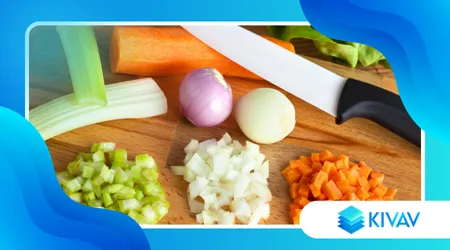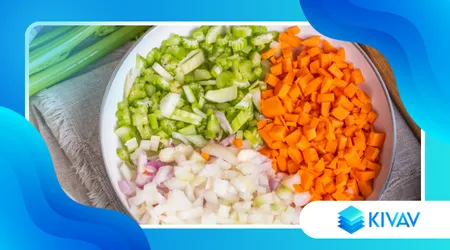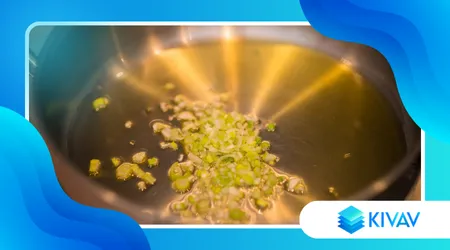How to make a perfect soffritto without burning the vegetables

Make a perfect soffritto without burning the vegetablesIn the vast universe of Italian cuisine, few basic ingredients are as crucial as a good soffritto.
Announcements
It is the starting point for countless recipes, the aromatic base that gives depth and flavor to sauces, stews, and risottos.
But how many of us have ruined a dish by burning garlic and onion?
Making a soffritto may seem simple. In reality, it's a subtle art that requires patience, attention, and the right technique.
The goal is to extract the maximum flavor from the vegetables, gently caramelizing them rather than charring them.
Announcements
The soffritto is the beating heart of many dishes. A good soffritto is invisible but omnipresent in the final flavor.
Imagine painting a picture: the soffritto is the carefully prepared canvas, ready to welcome the bright colors of the other ingredients.
The Essential Basics: Choosing the Right Ingredients and Tools
Before lighting the fire, choosing the right ingredients is essential. Onion, carrot, and celery—the famous "mince"—are the undisputed stars.
The quality of the vegetables affects the outcome. Use fresh, crunchy vegetables for a more intense flavor.
Besides vegetables, oil is another crucial ingredient. Extra virgin olive oil is the preferred choice due to its robustness and high smoke point.
Alternatively, you can use a mixture of oil and butter for a more rounded flavor.
Learn more: Using spices and herbs in Italian cuisine
Don't underestimate your tools. Choose a thick-bottomed pan that distributes heat evenly.
Ceramic or copper are excellent. Avoid thin pans that heat up too quickly, resulting in uneven cooking.

The Cooking Method: From Theory to Practice
The secret to a soffritto that doesn't burn lies in managing the heat. Always start with a low, or even very low, flame.
Add the oil to the pan and then add the finely chopped vegetables. Don't rush: this is where the flavor develops.
Learn more: Barolo Risotto with Sausage: The Intense Flavor of Piedmont
Once the vegetables are in the oil, it's essential to stir them constantly. The goal is slow, gentle cooking.
This “sweating” process releases water from the vegetables, softening them and making them translucent.
It is a critical step for make a perfect soffritto without burning the vegetables.
Many people make the mistake of turning the heat up too high. This speeds up the cooking process but burns the outside of the vegetables, leaving the inside raw.
This isn't the desired effect. Patience is a virtue, especially in the kitchen.
The Cold Water Technique and Heat Control
A lesser-known but very effective technique is adding a spoonful of cold water.
If the vegetables start to brown too quickly, add a little water. This lowers the temperature of the pan and slows the cooking process.
The soffritto must cook until the onion becomes transparent and the chopped mixture releases an unmistakable aroma.
Interesting: Focaccia with boiled potatoes
At this stage, the vegetables are sweet and ready to serve as the base for the dish. A burnt soffritto will have a bitter and unpleasant flavor.
A practical example: when preparing a Bolognese ragù, the soffritto of onion, carrot and celery must cook for at least 15-20 minutes.
Only then will it release its full aroma. It's not a race against time.

Not Just the Sauté: Variations and Applications
Another excellent example is the base for risotto. A soffritto of onion or shallot should be golden, not burnt.
This gives the risotto that creaminess and deep flavor that make it irresistible.
When it comes to garlic and chili pepper, the process is slightly different. Garlic has a more delicate texture and burns more easily.
Add it last, when the oil is already hot but not smoking, and remove it as soon as it turns golden.
An interesting statistic from the restaurant world is that 78% of professional chefs consider sautéing to be the most important step.
They believe that a well-made soffritto is synonymous with high-quality cuisine. And judging by the results, we can only agree.
Avoid Misunderstandings and Maintain Control
The pan should never be too crowded. This causes the vegetables to steam rather than fry, compromising the final result.
Another common mistake is not chopping vegetables evenly. Different-sized vegetables will cook at different rates.
For a scientific approach, the following table illustrates the smoke point of the most common oils:
| Type of Oil | Smoke Point (approximate) | Ideal for sautéing |
| Extra Virgin Olive Oil | 190-210°C | Yes, ideal |
| Sunflower Oil | 225°C | No, neutral flavor |
| Clarified Butter Oil | 250°C | Yes, for buttery flavor |
| Peanut Oil | 230°C | Yes, but it alters the flavor |
This table is a reminder for make a perfect soffritto without burning the vegetablesExtra virgin olive oil, due to its stability and flavor, remains the best choice.
The Sensory Impact: The Aroma of the Perfect Sauté
The aroma that emanates from the pan when the soffritto is ready is unmistakable. It's a sweet and complex aroma that previews the flavor of the final dish.
This is the sign that you have mastered the art of make a perfect soffritto without burning the vegetables.
Every chef knows that soffritto isn't just a simple "fry." It's a process of extracting flavors. The most fitting analogy is that of a symphony.
The soffritto is the foundational note, the basso continuo that supports and enriches all the other notes. Without it, the melody would be flat and lacking depth.
Patience Pays in the Kitchen
In summary, make a perfect soffritto without burning the vegetables It boils down to three key principles: heat control, patience, and quality ingredients.
Don't be afraid to slow down. The end result will justify every minute spent.
The difference between a successful soffritto and a burnt one is the difference between a memorable dish and one that will be forgotten. Isn't it worth taking such a risk?
Remember, cooking is an act of love and care. And a good soffritto is the first, fundamental step on this culinary journey.
Frequently Asked Questions
Can I use the food processor for sautéing?
Yes, but the vegetables may release too much water. It's always best to chop them by hand for better control over the consistency.
At what point do you add salt to the soffritto?
It is better to add salt at the end, or halfway through cooking, so as not to extract too much water from the vegetables at the beginning.
Can I prepare the soffritto in advance?
Yes, you can. It can be stored in the refrigerator in an airtight container for 2-3 days, but fresh soffritto is always best.
